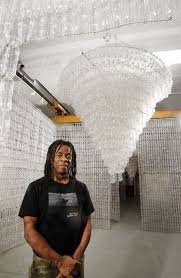Willie Cole is a contemporary American sculptor, painter, and conceptual and visual artist. His work uses contexts of postmodern eclecticism, and combines references and appropriation from African and African-American imagery. He also has used Dada’s readymades and Surrealism’s transformed objects, as well as icons of American pop culture or African and Asian masks.
Life
Willie Cole grew up in Newark, New Jersey. He attended the Boston University School of Fine Arts, received his Bachelor of Fine Arts degree from the School of Visual Arts in New York in 1976, and continued his studies at the Art Students League of New York from 1976 to 1979.
Works
Cole is best known for assembling and transforming ordinary domestic and used objects such as irons, ironing boards, high-heeled shoes, hairdryers, bicycle parts, wooden matches, lawn jockeys, and other discarded appliances and hardware, into imaginative and powerful works of art and installations.
In 1989, Cole garnered attention in the art world with works using the steam iron as a motif. Cole imprinted iron scorch marks on a variety of media, showing not only their wide-ranging decorative potential but also to reference his Cole’s African-American heritage. He used the marks to suggest the transport and branding of slaves, the domestic role of black women, and ties to Ghanaian cloth design and Yoruba gods.
Through the repetitive use of single objects in multiples, Cole’s assembled sculptures acquire a transcending and renewed metaphorical meaning, or become a critique of our consumer culture. Cole’s work is generally discussed in the context of postmodern eclecticism, combining references and appropriation ranging from African and African-American imagery, to Dada’s readymades and Surrealism’s transformed objects, and icons of American pop culture or African and Asian masks, into highly original and witty assemblages. Some of Cole’s interactive installations also draw on simple game board structures that include the element of chance while physically engaging the viewer.
His “Anne Klein With a Baby in Transit,” from 2009, uses discarded high-heeled shoes to depict a mother and child. The well-worn black shoes combine to recall traditional African sculptures. It was a gift from the Brenden Mann Foundation to the Minneapolis Institute of Arts.


